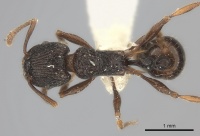Tetramorium wagneri
| Tetramorium wagneri | |
|---|---|

| |
| Scientific classification | |
| Kingdom: | Animalia |
| Phylum: | Arthropoda |
| Class: | Insecta |
| Order: | Hymenoptera |
| Family: | Formicidae |
| Subfamily: | Myrmicinae |
| Tribe: | Crematogastrini |
| Genus: | Tetramorium |
| Species: | T. wagneri |
| Binomial name | |
| Tetramorium wagneri Viehmeyer, 1914 | |
Nothing is known about the biology of Tetramorium wagneri.
Identification
Bolton (1977) - This is the only known species of the ornatum-group which has a notched or impressed anterior clypeal margin and because of this it runs out in· the key close to the members of bicarinatum-group where such a notch is universally present. However, the sculpture, form of the propodeal spines and petiole identify wagneri as a member of the ornatum-group.
Distribution
Distribution based on Regional Taxon Lists
Indo-Australian Region: New Guinea (type locality).
Distribution based on AntMaps
Distribution based on AntWeb specimens
Check data from AntWeb
Countries Occupied
| Number of countries occupied by this species based on AntWiki Regional Taxon Lists. In general, fewer countries occupied indicates a narrower range, while more countries indicates a more widespread species. |

|
Estimated Abundance
| Relative abundance based on number of AntMaps records per species (this species within the purple bar). Fewer records (to the left) indicates a less abundant/encountered species while more records (to the right) indicates more abundant/encountered species. |

|
Biology
Castes
Nomenclature
The following information is derived from Barry Bolton's Online Catalogue of the Ants of the World.
- wagneri. Tetramorium wagneri Viehmeyer, 1914c: 528, fig. 3 (w.) NEW GUINEA. See also: Bolton, 1977: 110.
Unless otherwise noted the text for the remainder of this section is reported from the publication that includes the original description.
Description
Worker
Bolton (1977) - TL 3.8-4.8, HL 0.90-1.06, HW 0.78-0.96, CI 86-92, SL 0.70-0.86, SI 86-92, PW 0.58-0.70, AL 1.06-1.28 (25 measured).
Mandibles coarsely striate. Clypeus with a median notch or impression of variable size, small in some individuals. Maximum diameter of eye c. 0.18-0.20. Frontal carinae stretching back beyond the level of the posterior margins of the eyes but behind this commonly broken or interrupted, their place taken by the very strong longitudinal carinate rugae of the head. In some specimens the carinae continue unbroken to close to the occipital margin. Occipital margin of head conspicuously concave in dorsal view. Propodeal spines very long, narrow, acute and slightly downcurved along their length. Metapleural lobes short, acute and triangular. Peduncle of petiole very long and downcurved, the node in profile high and quite narrow, the tergal portion of the node higher than the dorsal length. Clypeus with five or more longitudinal carinae of approximately equal strength, the dorsum of the head very strongly and coarsely sculptured with regular, sharp longitudinal carinae of which there are about 10 (number varies between individuals) between the frontal carinae at the level of the eyes. Cross-meshes between these carinae are completely absent. Ground sculpture between the carinae consists of faint superficial punctulation, which in many is almost effaced. Dorsal ali trunk reticulate-rugose. Sides of petiole and postpetiole with sparse longitudinal rugae but these are much fainter on the latter than on the former, vestigial in some. Dorsum of postpetiole unsculptured or at most with faint superficial shagreening or punctures. Gaster unsculptured. Fine hairs present on all dorsal surfaces of head and body but those on the dorsal (outer) surface of the hind tibiae short, much shorter than the maximum tibial width, and subdecumbent or decumbent. Colour dark reddish brown to blackish brown, the appendages lighter.
Type Material
Bolton (1977) - Holotype worker, New Guinea: Papua, Wareo (Berlin Museum für Naturkunde der Humboldt-Universität, Berlin) [examined].
References
- Bolton, B. 1977. The ant tribe Tetramoriini (Hymenoptera: Formicidae). The genus Tetramorium Mayr in the Oriental and Indo-Australian regions, and in Australia. Bull. Br. Mus. (Nat. Hist.) Entomol. 36: 67-151 (page 110, see also)
- Viehmeyer, H. 1914c. Papuanische Ameisen. Dtsch. Entomol. Z. 1914: 515-535 (page 528, fig. 3 worker described)
References based on Global Ant Biodiversity Informatics
- Bolton B. 1977. The ant tribe Tetramoriini (Hymenoptera: Formicidae). The genus Tetramorium Mayr in the Oriental and Indo-Australian regions, and in Australia. Bulletin of the British Museum (Natural History). Entomology 36:67-151.
- Bolton, B. "The ant tribe Tetramoriini (Hymenoptera: Formicinae. The genus Tetramorium Mayr in the Oriental and Indo-Australian regions and in Australia." Bulletin of the British Museum (National History): Entomology series 36, no. 2 (1977): 68-151.
- Chapman, J. W., and Capco, S. R. 1951. Check list of the ants (Hymenoptera: Formicidae) of Asia. Monogr. Inst. Sci. Technol. Manila 1: 1-327
- Janda M., G. D. Alpert, M. L. Borowiec, E. P. Economo, P. Klimes, E. Sarnat, and S. O. Shattuck. 2011. Cheklist of ants described and recorded from New Guinea and associated islands. Available on http://www.newguineants.org/. Accessed on 24th Feb. 2011.
- Viehmeyer H. 1914. Papuanische Ameisen. Deutsche Entomologische Zeitschrift 1914: 515-535.

